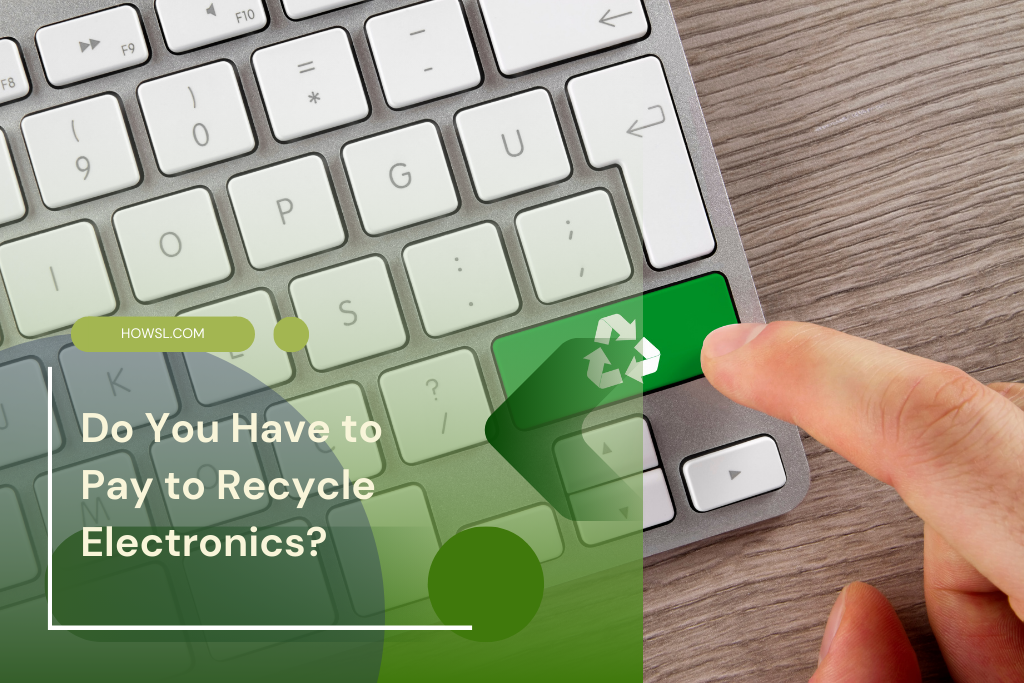Did you ever wonder, “Do you have to pay to recycle electronics?” Well, you’re not alone in this. Let’s journey together through the maze of electronics recycling and understand the costs behind it.
In our modern world, the surge of electronic gadgets has led to an inevitable rise in electronic waste. With technology advancing rapidly, old gadgets are tossed aside, creating a pressing need for efficient electronic waste recycling. But is this process free, or does it come with a cost attached? This article delves into the various facets of electronic recycling, exploring the associated costs, legislation, and consumers’ role in this eco-centric endeavor.
Key Takeaways:
- Electronic recycling is essential to mitigate environmental and health hazards.
- Costs are associated with recycling to ensure safe disposal and recycling practices.
- Legislation like the Extended Producer Responsibility model aims to share the recycling burden between manufacturers and consumers.
- Consumers may encounter fees either upfront or during the recycling process.
- Knowledge and adherence to local e-waste recycling laws and practices are crucial for a sustainable electronic lifecycle.
Federal Initiatives: Leading the Charge in E-Waste Management
Over the last ten years, federal policies have transformed the way we manage E-Waste in the U.S. Initiatives like the Responsible
Costs Associated with Electronic Recycling
The process necessitates advanced equipment and skilled personnel to ensure the safe handling and recycling of electronic gadgets, all of which come with a price tag.
Overview of Costs Incurred by Recycling Centers
Recycling centers incur various costs to ensure the safe and effective recycling of electronic waste. These costs can be broadly categorized into the following:
- Operational Costs: Running advanced recycling facilities requires substantial electricity, labor, and maintenance costs.
- Handling Hazardous Materials: Specialized procedures and equipment are needed to safely handle and dispose of the hazardous materials in electronic gadgets.
- Transportation Costs: Collection and transportation of e-waste to recycling facilities also contribute to the overall cost of recycling.
Table 1: Estimated Costs of Recycling Various Electronic Items
| Electronic Item | Estimated Recycling Cost |
|---|---|
| CRT TV | $0.40 – $0.60 per pound |
| LED/LCD Monitor | $0.20 – $0.40 per pound |
| Printer | $0.10 – $0.30 per pound |
Examples of Fees
Certain electronics come with a recycling fee, either upfront or upon disposal. For instance, consumers can expect to pay a fee when recycling TVs or monitors, with costs ranging from $0.40 to $0.60 per pound depending on the size and condition of the item<sup>[source]</sup>.
Legislation around Electronic Recycling
Legislation is crucial in managing electronic waste and ensuring manufacturers and consumers adhere to responsible recycling practices.
Extended Producer Responsibility Model
The Extended Producer Responsibility (EPR) model is a legislative framework adopted in 24 states, under which the manufacturer takes responsibility for recycling their products. The model aims to share the financial burden of recycling between manufacturers and consumers, ensuring a sustainable lifecycle for electronic products. Manufacturers under the EPR model contribute to the collection and recycling costs, thus reducing the financial burden on consumers and encouraging responsible recycling practices<sup>[source]</sup>.
- Variability Across States: The implementation and specifics of EPR legislation vary widely from state to state, with different products covered under the law.
Table 2: States with EPR Legislation for Electronic Waste
| State | Covered Electronic Items |
|---|---|
| California | TVs, Monitors, PCs, Laptops |
| New York | TVs, Monitors, PCs, Small Gadgets |
Fees Included in the Purchase Price
Some states have incorporated the recycling fee into the purchase price of electronics. This fee, although nominal, contributes to the larger ecosystem of e-waste management and recycling.
- Upfront Fee Model: Consumers pay a small fee upfront to fund recycling programs.
Table 1: Examples of Upfront Fees for Electronics
| State | Fee for TVs | Fee for Monitors | Fee for PCs |
|---|---|---|---|
| CA | $5 | $4 | $3 |
Fee at The Time of Recycling
In other instances, consumers might have to pay a fee at the time of recycling. For example, the cost to recycle a TV or monitor can range from $0.40 to $0.60 per pound<sup>[source]</sup>. This fee model ensures that those who contribute to e-waste also contribute to its proper disposal and recycling.
- Pay-as-you-recycle Model: Consumers pay based on the type and amount of electronics they recycle.
Table 2: Estimated Fees at Time of Recycling
| Electronic Item | Estimated Fee |
|---|---|
| TV | $0.40 – $0.60/lb |
| Monitor | $0.20 – $0.40/lb |
This first part of the article covers the imperative of electronic recycling, its associated costs, and the legislative efforts to manage e-waste responsibly. As we venture into the next part, we will delve deeper into consumer responsibility, different models of recycling fees, and how individuals can contribute to responsible electronic recycling.
Recycling Act (RERA) has halted the export of E-Waste to developing nations, setting a standard for responsible disposal.
The EPA’s robust programs, including the Resource Conservation and Recovery Act (RCRA), also ensure a well-defined path for handling hazardous waste.
These initiatives, combined with the National Strategy for Electronics Stewardship, pave the way for countries worldwide grappling with similar challenges.
The Role of Non-Profit Organizations in E-Waste Recycling
Non-profit organizations have long been pivotal in addressing environmental challenges and contributing to sustainable development. Their contribution to electronic waste recycling, also known as e-waste, is pressure-sensitive. E-waste includes discarded devices like computers, printers, mobile phones, and monitors, which, if not properly disposed of, may cause environmental hazards. Non-profit organizations worldwide engage in creative, innovative programs designed to mitigate these risks and recycle e-waste in an eco-friendly manner.
These organizations leverage various strategies that help raise public awareness concerning e-waste disposal, recycling procedures, and the negative effects of improper e-waste disposal. They often collaborate with local communities, educational institutions, businesses, and other bootstrap partners to drive impactful changes in e-waste management. Despite the operational challenges they often face, their programs consistently help reduce the amount of e-waste in landfills, promote responsible recycling, and contribute to creating a circular economy. These organizations’ role is increasingly vital in the face of growing global e-waste generation.
Non-Profit Recycling Programs
Many non-profit organizations have scaled up efforts to confront the growing menace of electronic waste, or e-waste, through innovative recycling programs. These programs include localized waste collection drives, education and awareness initiatives, and corporate partnerships to encourage the safe disposal and recycling of end-of-life electronics. They aim to mitigate the environmental impact caused by e-waste and champion the broader adoption of circular economy principles.

While recycling programs have traditionally emphasized household waste, non-profit organizations are adapting to the digital age by incorporating e-waste management. The widespread use of electronic devices in homes and businesses has led to a steady influx of e-waste, which ends up in landfills. Non-profits address this issue by providing accessible and responsible avenues for recycling electronic goods. Such programs are instrumental in diverting significant amounts of e-waste, thus reducing the potential for hazardous substances to impact the environment and human health.
Donating Electronics: The How-To Guide
Before you donate electronics to a non-profit:
- Ensure they are functional.
- Identify non-profits that accept such donations.
- Follow guidelines to erase personal data and reset devices.
- Obtain a receipt for tax benefits.
Remember, your small act can significantly impact the environment and society!
Corporate Responsibility in Electronic Waste Management
Corporations in today’s digital world have become a significant part of the waste management problem, particularly concerning electronic waste or E-waste. With an exponential increase in the production and consumption of electronic devices, the volume of E-waste has skyrocketed. This puts an enormous responsibility on corporate entities, as they are the primary producers of these electronic gadgets. It is now fundamental that corporations incorporate E-waste management into their business models and strategies, adopting sustainable practices that benefit both the environment and society.
Companies can undertake a variety of initiatives to manage their E-waste efficiently. Some of these strategies include using less hazardous materials in their products, designing devices with recycling and disposal in mind, offering take-back programs for old devices, and properly disposing of their E-waste through certified E-waste recycling facilities. Employees should also be educated about the importance of E-waste management, and corporations should work to increase transparency around their recycling practices. Corporate responsibility goes beyond generating profits, preserving the planet, and promoting sustainable living.
The Importance of the Electronic Waste Recycling Fee and the Costs of e-Recycling
Electronic waste (e-waste) is rising, with Americans spending significant amounts on electronics. As businesses and organizations allocate larger portions of their budgets to electronics, it’s crucial to understand the dynamics of recycling these products and the associated fees.
Understanding California’s eWaste Fees
California’s Electronic Waste Recycling Act ensures the appropriate collection and recycling of certain electronic devices due to their hazardous materials.
- What it includes: The law applies a recycling fee to select computer and television purchases.
- For whom: For institutions like UC San Diego, the recycling fee is factored into the cost of electronic purchases. The final bill includes the fee, whether buying from the UCSD Bookstore or other suppliers.
The fee varies based on the size of the device’s screen:
- Less than 15 inches: $4
- 15 to 34 inches: $5
- 35 inches or larger: $6
Which devices are covered? CEDs or Covered Electronic Devices include computer monitors, laptops, portable DVD players with LCD screens, devices containing cathode ray tubes, and televisions with various screen types.
For more details, check UCSD’s official page.
The Real Reasons Behind E-Recycling Costs
1. Changing Global Landscape
Formerly, electronics recyclers would export plastic waste to countries like China. However, bans in recent years have forced recyclers to find alternative, often more expensive, methods to handle these plastics.
2. Materials and Their Fluctuating Values
Today’s electronics contain diverse plastics, often with added chemicals, making recycling challenging. As the value of these materials diminishes, responsible recyclers face the tough choice: increase fees or compromise environmental integrity.
3. Evolution of Electronics
Modern gadgets are sleek, contain fewer precious metals, and are more complex than those from the ’90s. This shift impacts recyclers’ revenue streams, as newer devices offer less value from recyclable materials.
4. Investment in Equipment and Labor
The constantly evolving nature of electronics demands investments in modern recycling equipment. Coupled with labor costs and employee safety measures, these expenses contribute significantly to recycling costs.
5. Safeguarding Data and Ensuring Certifications
Maintaining high standards for data destruction and achieving certifications is not cheap. But it’s essential to ensure responsible and safe electronics recycling.
6. Ultimately, It’s a Service
Like garbage disposal, E-Recycling is a service. And quality service, ensuring environmental and data protection, comes at a cost.

FAQs
What Are The Common Fees Associated with Electronic Recycling?
The common fees associated with electronic recycling include upfront fees at the time of purchase and fees at the time of recycling, which may vary based on the type and amount of electronics.
What Is The Extended Producer Responsibility Model?
The Extended Producer Responsibility (EPR) model is a legislative framework that places the responsibility of recycling on the manufacturer, thereby sharing the financial burden of recycling between manufacturers and consumers.
How Can I Find Local Recycling Centers?
Local recycling centers can be found through municipal websites or by contacting local environmental agencies.
Making E-Recycling Cost-Effective
While some costs are inevitable, choosing the right recycling partner can help manage expenses. For instance, partnering with companies like Sadoff E-Recycling & Data Destruction has saved businesses up to 50% of their annual recycling expenses.
What is corporate responsibility in electronic waste management?
Corporate responsibility in electronic waste management refers to the ethical obligation of businesses to properly dispose of electronic waste, often through recycling or other environmentally friendly methods.
How are federal initiatives involved in E-Waste Management?
Federal initiatives in E-Waste Management often involve implementing regulations and laws that require businesses and individuals to dispose of electronic waste properly. These initiatives can also support recycling programs and fund research into more effective e-waste management methods.
What is the role of non-profit organizations in E-Waste recycling?
Non-profit organizations often play a significant role in E-Waste recycling by providing services to collect and properly dispose of electronic waste. They also often engage in educational efforts to raise awareness about the importance of e-waste management.
What are some examples of non-profit recycling programs?
Non-profit recycling programs may include collection drives for electronic waste, initiatives to refurbish and reuse electronics, and programs to recycle materials from old electronics. These programs vary widely in scope and reach, but all contribute to the goal of reducing e-waste.
How can I donate electronics to non-profits?
There are several ways to donate electronics to non-profits. Often, these organizations have drop-off locations where you can bring old electronics. Some also offer pick-up services. It’s always a good idea to check with the organization first to see what electronics they accept and how to prepare your items for donation.
In Conclusion
Though it might feel counterintuitive to pay for recycling, the process involves various complexities, operational expenses, and global market dynamics. With the environment at stake, it’s essential to understand and appreciate the intricacies of e-recycling.
So, the next time you ask, “Do you have to pay to recycle electronics?” remember the intricate processes and responsibilities behind that fee. And always strive to make an informed choice for a sustainable future.
